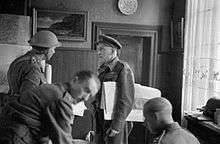Victor Fortune
Major General Sir Victor Morven Fortune KBE CB DSO DL (21 August 1883 – 2 January 1949) was a senior officer of the British Army. He saw service in both World War I and World War II. He commanded the 51st (Highland) Infantry Division during the Battle of France and was subsequently trapped and obliged to surrender to the Germans on 12 June 1940.
Sir Victor Morven Fortune | |
|---|---|
 Major General Victor Fortune, commanding 51st (Highland) Division, at his HQ at Le Caudroy, France on 8 June 1940. | |
| Born | 21 August 1883 Blelack, Scotland |
| Died | 2 January 1949 (aged 65) Dalswinton, Scotland |
| Allegiance | |
| Service/ | |
| Years of service | 1903–1945 |
| Rank | Major General |
| Commands held | 1st Battalion, Black Watch (Royal Highland Regiment) 46th Infantry Brigade 1st Battalion, Seaforth Highlanders 5th Infantry Brigade 52nd (Lowland) Infantry Division 51st (Highland) Infantry Division |
| Battles/wars | World War I World War II |
| Awards | Knight Commander of the Order of the British Empire Companion of the Order of the Bath Distinguished Service Order Légion d'honneur (France) Order of the Phoenix (Greece) |
| Other work | Deputy Lieutenant, County of Perth Honorary Colonel, The Seaforth Highlanders |
Military career
Fortune was commissioned as a second lieutenant into the Black Watch (Royal Highlanders) in 1903 and served in the First World War as Commanding Officer (CO) of the 1st Battalion, Black Watch (Royal Highlanders) from 1916[1] and Commander of the 46th Brigade from 1918.[2]
After attending the Staff College, Camberley from 1920 to 1921, he became CO of the 1st Battalion, Seaforth Highlanders in 1927 and Commander of the 5th Infantry Brigade in 1930.[1] He became General Officer Commanding (GOC) of the 52nd (Lowland) Infantry Division in 1935 and GOC of the 51st (Highland) Infantry Division in 1937.[1]
The 51st Division remained in France after the general evacuation from Dunkirk, having been assigned to the French IX Corps. After naval evacuation proved impossible and supplies of ammunition had been exhausted, Major-General Fortune was forced to surrender the greater part of the Highland Division at St Valery en Caux.[3]
Fortune spent the rest of the war as a prisoner of war. As senior British officer in captivity in Germany, he worked to improve the conditions of the men under his command. He suffered a stroke in 1944 but refused repatriation.[1] He was finally liberated in April 1945 and made KBE shortly after.[1]
Several British writers have questioned the decision to remain with the French during the battle. However, General Charles de Gaulle stated, 'For my part, I can say that the comradeship of arms, sealed on the battlefield of Abbeville in May–June 1940, between the French armoured division, which I had the honour to command, and the gallant 51st Scottish Division under General Fortune, played its part in the decision which I made to continue the fight at the side of the Allies, to the end, come what may'. And he concluded by quoting the old motto of the Garde Ecossaise: omni modo fidelis - faithful in every way.[4]
References
- "Major General Fortune". 51 Highland Division. Retrieved 20 June 2020.
- "Victor Fortune". Generals.dk. Retrieved 20 June 2020.
- "The Heroes of St Valery". Retrieved 20 June 2020.
- "Speech delivered by General de Gaulle at Edinburgh". 23 June 1942. Retrieved 20 June 2020.
External links
| Military offices | ||
|---|---|---|
| Preceded by Andrew McCulloch |
GOC 52nd (Lowland) Infantry Division 1935–1936 |
Succeeded by Andrew McCulloch |
| Preceded by Douglas Brownrigg |
GOC 51st (Highland) Infantry Division 1938–1940 |
Succeeded by Post captured in 1940 |